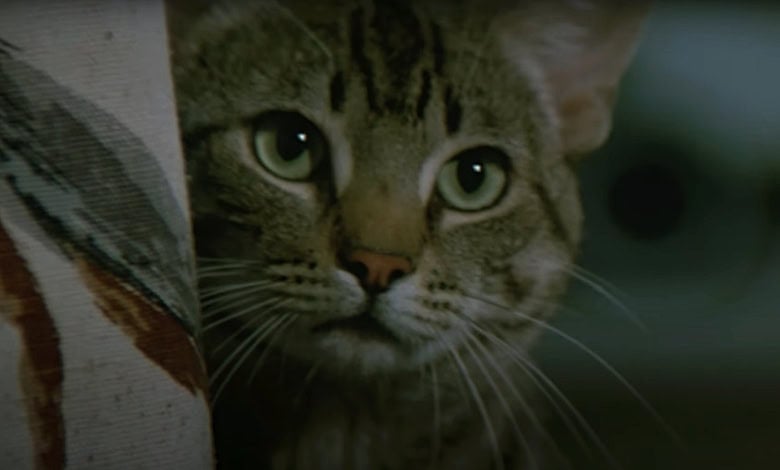
“Stephen’s King’s Cat’s Eye” (1985, which King wrote, and Lewis Teague directed, is set in a time when King was as present in pop culture as Walt Disney.
While King’s popularity has never waned, there was a moment when his name and works were ubiquitous. You couldn’t go to a bookstore, turn on a TV, read a magazine or go to a multiplex and not see his name, seemingly everywhere.
In the mid-’80s, King’s novels, TV-movies and film adaptations, magazine cover stories and TV interviews were unavoidable. The enjoyable quality of “Stephen King’s Cat’s Eye” is that, right from the start, the film knows we’re living in King’s world.
After an eerie, dazzling opening title shot (in which the screen is engulfed by a feline’s pupil), we see a cat running through suburbia, encountering characters from King’s movies. “Cujo” the dog and “Christine” the killer car make cameo appearances, the first of many out-in-the-open nods to King’s omnipresence in pop culture.
Later, characters are seen reading his books and watching his movies. Rather than a cheeky joke, it feels just right. After all, why wouldn’t King be as popular in one of his screenplays as he is in real life?
RELATED: HOW ROB REINER SAVED STEPHEN KING MOVIES
The cat, who is later named “General,” is on an odd quest, being led to the home of a young girl named Amanda (Drew Barrymore, utterly adorable), who summons the feline to protect her. It’s a strange concept that the story never resolves (when the cat finally gets to Amanda, there’s no explanation of the psychic connection between them and the plot angle is dropped altogether).
Yet, as a plot line to string together the three stories (two of which are adaptations from King’s 1978 “Night Shift” collection), it keeps us intrigued. Also helping enormously is that the cat in question is likable and “acts” convincingly.
The animal’s trainer somehow makes us believe that “General” is driven, compassionate and on-edge (as opposed to bored, hungry, tired and annoyed, like most normal cats).
FX legend Carlo Rambaldi with his troll from Stephen King’s CAT’S EYE https://t.co/ZocdZIYN2S pic.twitter.com/lqu4l9Ux9C
— Body Snatchers (@BodySnatchers79) April 12, 2024
The first vignette, “Quitters Inc.,” is the film’s best, smartest sequence. The cat winds up in New York and comes into the life of a chain smoker (James Woods) who tries to quit his habit by enrolling in a “radical” new form of therapy.
The No Smoking guru is played by Alan King, and the sequence, both diabolical and quite funny, has an appropriate, if jarring, mean streak. Woods and King are visibly taking their roles seriously, but only to a point and appear to be enjoying themselves.
A party sequence at the mid-point doesn’t really work (the comic relief is too much), but the wrap-up and surprise at the end are chilling.
The cat escapes from King’s clutches and winds up in Atlantic City for the second story, “The Ledge.” Robert Hays plays an unfortunate soul who, against his will, must climb along the edge of a tall building.
The forced perspectives, miniatures and sets are so good, the sequence conveys the horror of being stuck on the side of a building, with every step a bet against gravity.
Somehow, the cat (who is quite the traveler) ditches the high rise and winds up in suburbia for the third vignette. He finally connects with Barrymore’s Amanda, who is terrorized by a monster living in her bedroom wall.
As a kid, this was my favorite sequence – what’s not to love about a cat fending off a gruesome but goofy troll who attacks you as you sleep? As in the prior episode, the sets and special effects are exceptional.
Director Teague (whose prior film was the terrifying “Cujo” in 1983) appears to be having fun and so does everyone else. Barrymore’s multiple appearances are striking, particularly the touching way she plays Wood’s special-needs daughter in the first sequence.
Alan Silvestri’s synthesizer score can be corny, but his title theme is seriously spooky. So is much of “Cat’s Eye,” which has an edge and earns its PG-13 rating, though it’s still sillier and more fun than most King adaptations.
While not on the level of brilliant works like “The Shining” (1980), “Misery” (1990) or “The Shawshank Redemption” (1994), “Stephen King’s Cat’s Eye” is nastier, pulpier and even weirder than his earlier “Creepshow.” It demonstrates that, in the movies as well as real life, people read an awful lot of Stephen King novels.
